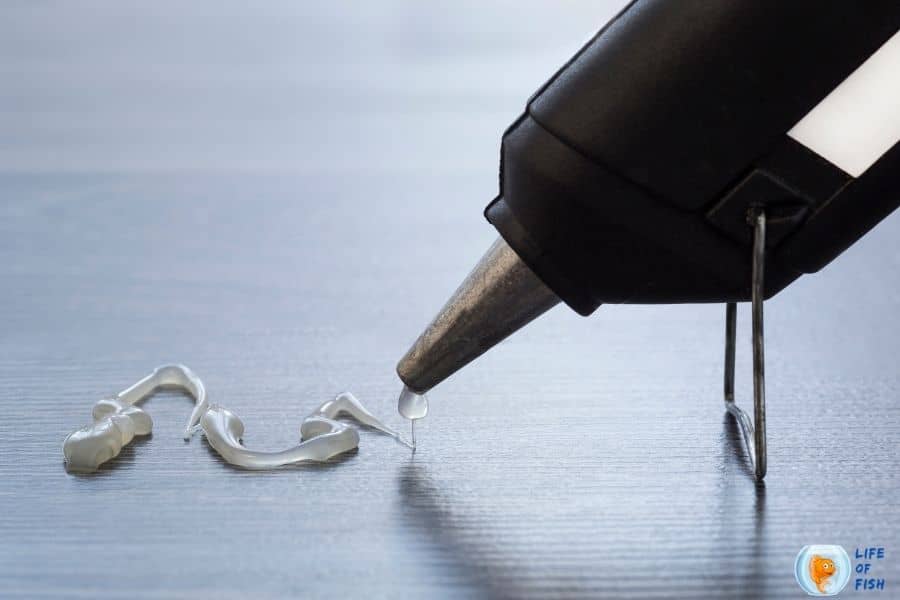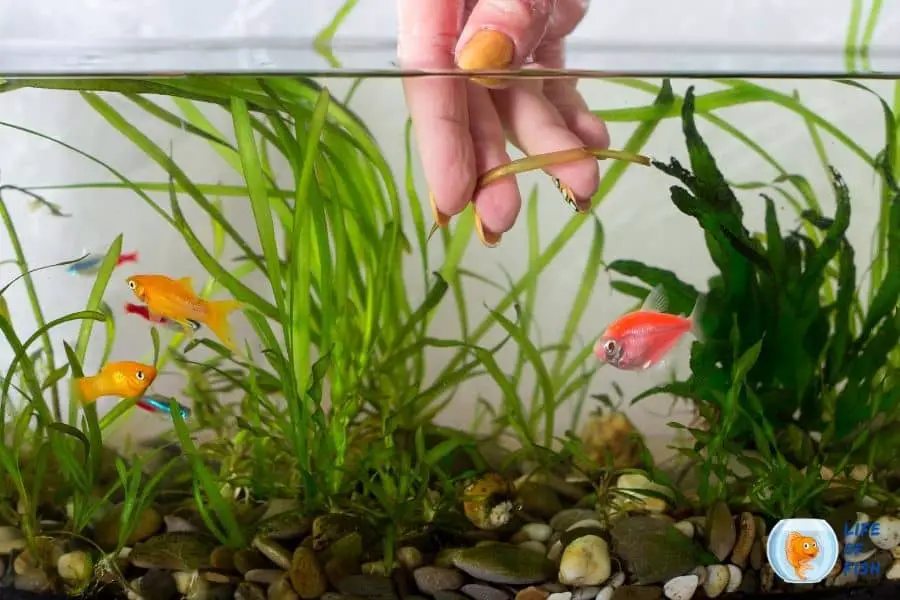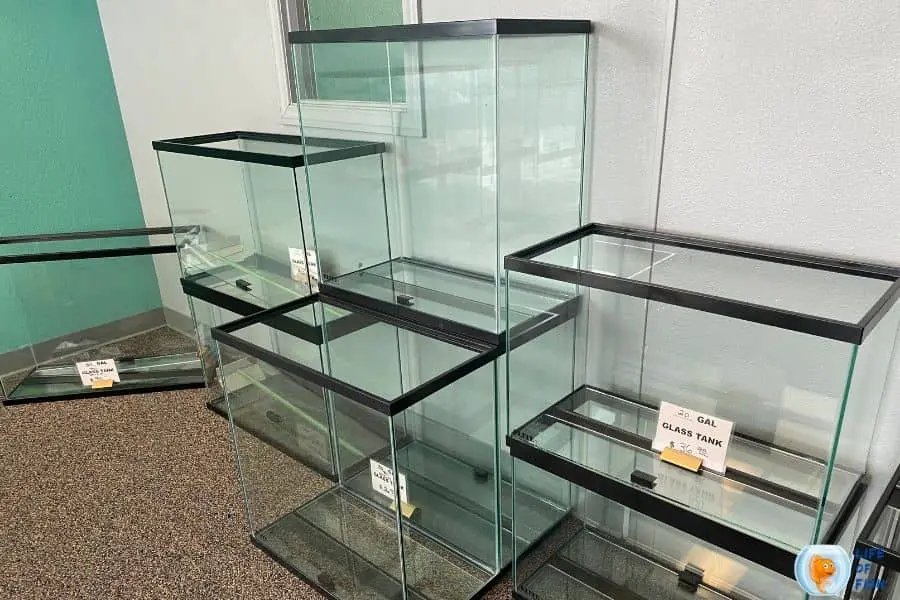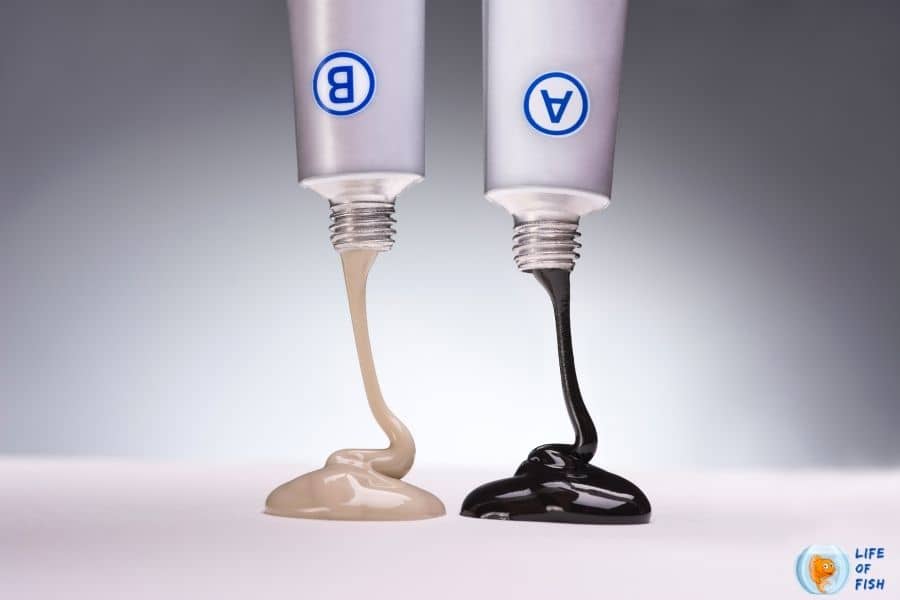Many of us enjoy having an aquarium at home. But we have this question ahead of us; is hot glue aquarium safe?
Yes. Hot glue is completely safe for use in and around water. Hot glue does not contain any harmful chemicals. It is also non-toxic to fish and other animals in the water. Therefore you can use hot glue to repair broken objects inside the tank. But there is a drawback to using hot glue in aquariums. This article will convey the benefits and drawbacks of using hot glue in your aquarium and other alternative adhesive options that are safe for aquarium use. Read for more.

What is hot glue?
Jump To
- 1 What is hot glue?
- 2 What Makes Hot Glue Aquarium Safe?
- 3 How hot glue works?
- 4 The Benefits of Hot Glue
- 5 Can I use a hot glue gun in the aquarium?
- 6 Is hot glue toxic in water?
- 7 Is hot glue toxic when dry?
- 8 How long will hot glue hold?
- 9 How long does hot glue take to dry?
- 10 How long does hot glue take to cure?
- 11 What can you stick with a hot glue gun?
- 12 What glue is safe for aquariums?
- 13 Conclusion
Hot glue is an adhesive that is used by heating it up and applying it to surfaces. It begins as a solid but then melts into liquid form when heated, allowing you to apply it in an adhering manner.
To make hot glue, we need to have glue sticks and a hot glue gun. A hot glue gun is a portable tool that melts the glue stick in order to allow you to apply it. Glue sticks are available with different melting points, and they can be used accordingly based on your needs.
What Makes Hot Glue Aquarium Safe?
The main ingredients of hot glue sticks are polymer resin and polystyrene. The formula of hot glue is similar to the plastic used in baby bottles, disposable cups, and water cooler jugs.
Polymer resin and polystyrene are ground into a fine powder form and then mixed together using an industrial mixer (similar to one found on a manufacturing floor). This mixture is heated until it becomes liquid form.
Another ingredient, colophony, is then added to the liquid mixture to give it its adhesive properties and allow it to cool into a solid state that can be used as sticks of hot glue. The cooling process takes about an hour for every 100 grams of liquid being cooled.
How hot glue works?
Hot glue works by first heating the glue sticks with a hot glue gun so the liquid hot glue will come out of its nozzle. Then as you apply pressure to your project, the liquid sticks to both surfaces and cools down, creating a solid bond. The heat melts the glue, and as it cools, it turns back into a solid.

The Benefits of Hot Glue
The main benefit of using hot glue is that it can quickly adhere just about anything together, so if you need something fixed right away, this might work for you. It also does not leave any residue after use which makes it one of the best adhesive options.
Can I use a hot glue gun in the aquarium?
Yes. You can use a hot glue gun in an aquarium. Hot glue is completely safe for use around water, but there are some drawbacks to using hot glue in aquariums.
When hot glue is exposed to water, it releases fumes that can harm your fish. But if you put the bonded equipment after the hot glue cools down completely, it will be completely safe for the aquarium life.
The main drawback of using hot glue in an aquarium is that the bond will not hold longer compared to other aquarium sealants.
Is hot glue safe for aquarium plants?
Hot glue is not safe for live aquarium plants because it uses heat to melt the glue to stick, which is not good for the plants. If used, the plant may die because of heat damage in the bonded area. You can use hot glue safely if you are gluing fake or plastic plants to a tank.
Is hot glue safe for aquarium substrate?
Hot glue is not safe to use as an adhesive on substrates such as gravel or sand because it will stick to them and clog up your tank, which can lead to a dead fishy feast.
Is Hot Glue Safe For Aquarium Decorations
If you want decorations in your fish tank, hot glue may not be the best choice. It will make a bond, but as you put it underwater, the adhesive slowly separates from the surface, which could lead to your decorations falling apart in a couple of days.
Is Hot Glue Safe For Aquarium Rocks?
Hot glue is safe for aquarium rocks because rocks don’t get affected by heat in any way. The disadvantage of using hot glue is that it doesn’t hold up for long.

Is hot glue toxic in water?
Hot glue can be toxic in water if you directly pour hot glue into the water (which you will not because the hot glue gun will break underwater). Hot glue is entirely safe after it is cured in a dry place for at least 24 hours.
Is hot glue toxic when dry?
Hot glue is not toxic when dry. When completely cured, hot glue becomes a plastic-like material and becomes inert. So, it is completely safe to use in any material when dried.
How long will hot glue hold?
Hot glue is permanent when used on dry and clean surfaces. But, it will not hold up if used on wet or dirty surfaces because of the water content that makes glue lose its grip.
How long does hot glue take to dry?
Hot glue takes about 30 seconds to a minute to dry when heated with a low heat setting of your gun (if you are using an electric hot glue gun).
How long does hot glue take to cure?
Hot glue takes 12 hours or more to cure completely.
You can speed up the process by using a hairdryer on low heat settings but, you need to wait for at least 24 hours before putting your fish tank decorations in water.
What can you stick with a hot glue gun?
Glue guns are widely used in the production of modern furniture.
You can use hot glue to stick wood, paper, cardboard, hardboard, electric device peripherals such as displays, covers, batteries, and anything that is clean and dry.

What glue is safe for aquariums?
You can not use just any glue in aquariums as some adhesives contain toxic ingredients for your fish. Apart from hot glue, several other adhesives are safe to use in aquariums.
Super Glue
Super glue is the main go-to adhesive of most aquarium owners because it is safe for aquatic life and takes only seconds to cure.
Some sources say that superglue is not safe for fish because of the toxic hardening agents it holds. But, many hobbyists vouch for super glue being safe for the fish.
If you are a guy that concerns about your fish safety, then we would recommend searching for a super glue product that contains “Ethyl Cyanoacrylate” as the main ingredient.
Products that use “Ethyl Cyanoacrylate” are completely safe both for freshwater aquariums and saltwater aquariums.
Aquarium safe silicon
aquarium safe silicon is the main adhesive that is used to build glass aquariums. We can safely say that this adhesive is completely safe for aquarium use by the name of it.
Silicon does best with glasses because it has an incredible bonding strength with glasses. That is why hobbyists use silicon to build glass aquariums and to fix cracks off aquariums.
When choosing silicon for your aquarium, make sure that it contains 100% silicon. Some silicon adhesive products contain additives to cure faster. You need to stay away from these additives. Some of them are,
- Bacterial Protection
- Anti-Microbial
- Mildew Resistant and
- Mold Inhibitor
Some product manufacturers clearly state if their product is safe or not safe for aquariums. So, when choosing a silicon product, always go for an “Aquarium safe silicon” adhesive.
Epoxy
Epoxy is not a “true” glue. It is a two-part adhesive that you need to mix together for bonding. Epoxy gives off a very strong bond, but it can take up to 24 hours to cure fully.
The two main ingredients of this adhesive are resin and hardener. Aquarium-safe epoxy products usually take only 2 to five minutes to cure underwater. Epoxy is considered safe for aquariums, and it works like a charm with freshwater and saltwater tanks.
When choosing epoxy, always go for an “Aquarium Safe” product that does not contain Isocyanates or hazardous solvents such as n-butyl acetate or ethyl acetate, heavy metals (such as cadmium, chromium, and lead), or formaldehyde.
While “Aquarium safe” epoxy is safe to use even underwater, the disadvantage of these products is their higher price.

Aquarium safe cement
Aquarium safe cement is another leading adhesive used in the aquarium industry, mainly in the world’s largest aquariums. They use a chemical reaction at the molecular level to melt the two pieces you want to join that form a firm bond. Aquarium-safe cement falls under two main categories.
Acrylic Materials
We use acrylic cement to bond sheet material primarily. Most sumps are made of acrylic panels that have been machined square and flat and then glued together with acrylic cement.
Many large aquariums build massive windows using these acrylic materials, forming incredibly thick acrylic sheets and bonding them together.
There are two types of acrylic cement.
- A solvent-based water-like solution that is used for gluing sheet edges. This solvent penetrates the joint by capillary action and then evaporates, leaving a molecularly linked junction.
- A thicker get-type cement is used to construct items with gaps in the seams—frag Racks, baffles, and so on.
Acrylic adhesives are usually a costly option and suitable for giant aquarium use. If you own a home aquarium, it will be best to opt for a cheaper option like super glue.
PVC & ABS materials
It is not unusual to find PVC or ABS pipes in aquariums. And, these materials need a particular type of adhesive to bond together. PVC and ABS adhesive use molecular bonding to stick two pieces together and make a robust and waterproof joint.
Important: All of these adhesives are not safe to use underwater (except aquarium-safe epoxy) because they release toxic fumes while curing that can harm or kill your fish. So, use them only when you will not have water in the aquarium for at least 24 hours.
Or else, remove the part you need to glue on and keep it aside for at least 24 hours after bonding the pieces together.
Conclusion
While hot glue is safe to use in aquariums, it is not the best choice to stick things in aquariums. It will not hold longer like other aquarium-safe adhesives, so we only recommend hot glue as a temporary fix for a broken part until you fix it permanently with more powerful glue. If you have access to any other glue that we have listed above, use it instead so that you can have a long-lasting bond.
Read Next: How To Get Rid Of Mosquitoes In Fish Tank | 6 Useful Hacks |
